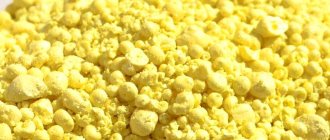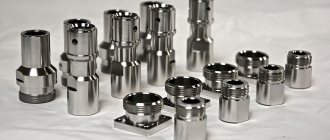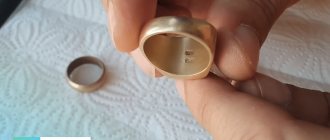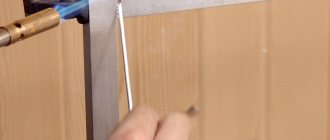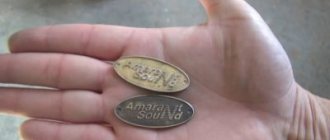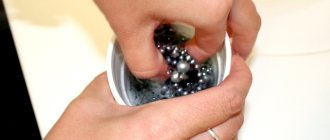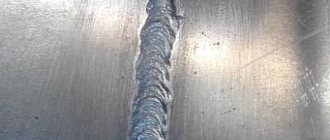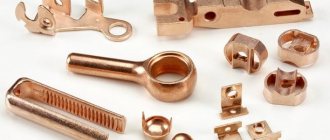Blackening aluminum at home: means, methods, procedures, tips
- November 27, 2018
- Miscellaneous
- Tamila Gresko
Due to the fact that most steel grades are susceptible to corrosion, they begin to rust when in contact with water. This can also happen if the product is placed in a room with high humidity. Of course, the corrosion process can be prevented if the steel surface is wiped dry every time. Anti-corrosion paint is mainly applied to metal products using a brush or by spraying.
However, this is not a solution to the problem if the design includes threaded connections or moving parts. The best option in such cases would be the bluing process. Despite the fact that rust does not form on aluminum, judging by the reviews, it happens that the owner wants to blacken this metal. This procedure can also be recommended for this purpose. It is also called blueing. But if we adhere to technical terminology, then this process is more correctly called oxidation. How to blacken aluminum? What will you need for this? You will find information on how to blacken aluminum at home in this article.
How to blacken aluminum at home
The essence of the anodizing process is the build-up of an oxide coating, which on aluminum and its alloys performs a protective function against environmental influences. Another name is anodic oxidation. In addition, oxidation is used to improve the aesthetic appearance of products.
Surface defects are eliminated - small scratches, small chips. You can imitate coating with precious metals or increase adhesive properties. The coating can be applied not only at work, but also at home.
Anodizing aluminum at home is very popular among DIYers. In products subjected to anodic oxidation, the durability of the protective coating increases.
Aluminum anodizing
Electrolyte preparation
Acid solutions are considered unsafe reagents, so to anodize aluminum at home, they resort to a different type of solution. To prepare it, use salt and soda, which you always have on hand.
To prepare the electrolyte, take two plastic containers. They are filled with salt and soda compositions, observing the proportion: per serving of salt or soda 9 servings of distilled water.
Anodizing at home
After dissolving the components, the solution is kept to allow undissolved particles to settle to the bottom. When pouring into a container for anodizing, it must be strained.
Aluminum anodizing methods
Several methods have been developed for processing aluminum alloys, but the chemical method in an electrolyte environment has found widespread use. Acids are used to obtain a solution:
- sulfur;
- chrome;
- oxaline;
- sulfosalicylic acid.
To impart additional properties, salts or organic acids are added to the solution.
At home, sulfuric acid is mainly used, but when processing parts with complex configurations, it is preferable to use chromic acid.
The process occurs at temperatures from 0°C to 50°C.
At low temperatures, a hard coating forms on the surface of aluminum.
As the temperature rises, the process proceeds much faster, but the coating is highly soft and porous.
Aluminum hard anodizing technology
In addition to the chemical method, in some cases the following methods of aluminum anodization are used:
- microarc;
- color:
- adsorption;
- immersion in electrolyte;
- dipping into a dye solution;
- electroplating;
- interference;
- integral.
Warm anodizing
The warm anodizing method is used to obtain a base for painting. The coating is porous, but due to this it has high adhesion. Epoxy paint applied on top will reliably protect the aluminum from external influences.
The disadvantage is the low mechanical strength and corrosion resistance of the coating. It is destroyed upon contact with sea water and active metals. This method can be done at home.
The process takes place at room temperature or higher (no more than 50°C). After degreasing, the workpieces are mounted on a suspension that holds them in an electrolyte solution.
Anodizing continues until a milky coating appears on the surface. After removing the stress, the workpieces are washed in cold water.
The parts are then painted. They are dyed by placing them in a container of hot dye. After that, the obtained result is consolidated for 1 hour.
What is the essence of the procedure?
Before you start blackening aluminum at home, you should understand what the meaning of this process is. According to experts, its essence is to create conditions in which a film of iron oxide would form on a metal surface. Depending on which method of aluminum bluing was chosen, its thickness can range from 1 to 10 microns. There are three ways to influence metal. Consequently, blackening of aluminum at home can be thermal, acidic or alkaline. In the first case, the product is heated, and in the other two it is processed in an appropriate solution. During bluing, the tarnish colors on the surface will change. The master only needs to decide on the desired color of oxidation and stop the process in time.
How to blacken aluminum at home - Metals, equipment, instructions
The essence of the anodizing process is the build-up of an oxide coating, which on aluminum and its alloys performs a protective function against environmental influences. Another name is anodic oxidation. In addition, oxidation is used to improve the aesthetic appearance of products.
Surface defects are eliminated - small scratches, small chips. You can imitate coating with precious metals or increase adhesive properties. The coating can be applied not only at work, but also at home.
Anodizing aluminum at home is very popular among DIYers. In products subjected to anodic oxidation, the durability of the protective coating increases.
Aluminum anodizing
About ferric chloride
Judging by the reviews, some home craftsmen etch printed circuit boards and thus obtain a liquid for blackening aluminum. Next, shiny metal parts are lowered into this mining for a certain time. Those who are interested in how to blacken aluminum at home can be advised not to complicate the process by etching the boards, but to immediately acquire ferric chloride to make the required solution. You can work with this method both with aluminum and with duralumin, steel and brass.
Judging by the reviews, aluminum surfaces are best blackened. With duralumin the situation is somewhat worse. Steel ones, according to the craftsmen, practically do not blacken. However, they develop a specific coating that can be confused with rust. However, the steel surface is no longer so shiny and looks much better. Brass products after treatment in ferric chloride also do not become black, but acquire a matte reddish tint.
Cleaning agents for aluminum products
How to clean the contamination also depends on what caused the darkening of aluminum. Therefore, to remove plaque, you need to be patient and use several proven methods.
If you need to clean cooking utensils in which food has burnt, it is best to soak the utensil in warm water. After this, washing the product will be much easier. Residues of food will come off on their own when exposed to moisture; all that is required is to wash the pan with a soft sponge and dishwashing detergent.
Among purchased products, it is better to give preference to special products designed for processing glass and porcelain.
Such detergents perform excellent cleaning functions and also add additional shine.
If oxidation has affected the aluminum thoroughly, then more stringent renewal methods will be required. In this case, ordinary table salt mixed with clean water in a 1:1 ratio will help. Rub the resulting mixture onto the damaged product and carefully walk the sponge over the surface.
Cream of tartar works very well with aluminum and can easily remove dark stains. To do this, dissolve 3 tbsp in 5 liters of warm water. l. product and soak the product itself in the resulting solution, leave for 3 hours. After this, all the dirt will come off on its own, the housewife will only have to rinse and wipe the products dry.
Cream of tartar may not always be on hand, so vinegar or citric acid is suitable for these purposes. They should be taken at the rate of 4 tbsp. l. acid per 1 liter of warm water and leave until completely cool. As a precaution, you should use gloves to prevent possible irritation on your hands.
For particularly advanced cases, you can make your own special remedy. You will need 100 g of office glue, 5 liters of water and 1 tbsp. l. baking soda. All ingredients are combined and brought to a boil, after which aluminum is placed into the solution and left to cool. The product is rinsed well under running water and wiped dry. Instead of soda, you can take 100 g of grated laundry soap. It will help prevent the formation of possible scratches that may appear due to soda particles.
Ordinary white clay, as well as tooth powder, will also help restore aluminum to its former shine. It is enough to use them as a cleaning agent. They work quite gently, but effectively.
Grandma's recipe for cleaning pots involves using cabbage leaves. It contains enzymes that help remove darkening. In addition, you can treat the contaminated surface with brine from cucumbers or tomatoes, or whey. They fill the pan with them for at least 24 hours, and under the influence of a weak acid, all black stains are removed without damaging the protective shell.
How to burnish with iron chloride? Where to begin?
If small-sized aluminum products are to be processed, then you can limit yourself to 15-20 grams of this substance. Blackening aluminum at home using ferric chloride consists of several stages. First of all, you should prepare everything for work. First, ferric chloride is diluted with water. It is important that the mixture is easy to spread. To make it thick and not spread, you need to take a small amount of water. Next, the solution must be given time to brew. During this time, you can prepare the product itself for bluing: remove dirt and dust from its surface, and then degrease it. Judging by the reviews, it is enough to wash it under the tap with soap.
Burnishing aluminum at home
Applying a paint coating to the surface of metal products is a way to make parts beautiful and protect them from deformation or the formation of a corrosive layer.
There are not only special paints, but also a bluing method, which is characterized by the use of iron oxides during a chemical reaction.
As a result, it is possible to obtain a surface with a unique appearance and strong resistance to external factors.
Features of metal painting
A huge number of dyeing methods have expanded the color base. Depending on the method of applying the paint and varnish coating and the oils, acids and varying degrees of heating used, it is possible to create any color, even lemon color.
All paint application options are divided into two types:
- mechanical;
- chemical.
When applying paint mechanically, various powders are used, which are sprayed, splashed, hammered in using special tools. This option is not distinguished by quality, beauty or uniqueness, but is appreciated by car enthusiasts due to its low cost. In addition, mechanical painting can be easily done at any service station or even with your own hands if you have the necessary equipment.
The use of the chemical method requires experience and knowledge of the sequence of the entire procedure. The first thing to do is to strip the metal surface of the old paintwork.
Next, the damaged areas of the primer are restored, which are previously cleaned of rust. After the metal acquires an ideal surface, it is degreased. Small oil removal parts are placed in solvents such as gasoline, ethyl or ether.
The treated parts are immersed in boiling water and only then subjected to chemical staining.
Applying a paint coating is not enough if you want the metal to acquire an elegant look and shine of the surface and remain so even with frequent use. This problem is solved by oxidizing the steel.
This procedure involves rubbing the surface with mixtures such as:
- nitric acid mixed with alcohol, water and copper sulfate in the form of sawdust;
- inky-nut-colored acid, including iron and antimony;
- silver nitrate with added water;
- olive oil with antimony chloride.
After applying one of these mixtures to a metal surface, it is subjected to heat treatment. The result of the work will depend mainly on how well the part was cleaned from grease, dust and dirt.
This method is often used to protect weapons and car parts from scratches and chips. Protection can be achieved in other less effective but cheaper ways. For example, many people do metal bluing with oil at home, which, thanks to the crystalline structure of the protective layer of paint, penetrates and creates shine and an additional layer of protection.
If you are doing all the work yourself, then it is important to remember that after drying the painted metal will look darker than when wet. Therefore, taking into account such features, you need to adjust the color in an acceptable direction.
DIY blackening methods
There are a large number of ways to blacken a steel surface. The most popular of them include the use of alkaline, acidic solutions or heat treatment. Each of these methods requires special equipment, but some options for bluing steel material can be done at home.
A simple, cheap and safe method involves processing metal using an alkaline material. For bluing with alkali, you will need to additionally find and prepare:
- sodium hydroxide;
- sodium nitrate;
- water;
- digital scales;
- protective clothing.
The list of protection must include gloves, boots and a respirator. For the rest of the protection, old clothes will do. Some formulations require nitrate or phosphoric acid.
To process metal parts, you need stainless steel utensils, otherwise chemical reactions with alkali may occur.
Burnishing is carried out at a certain temperature, so the solution is first poured into a container and brought to a boil. The alkaline solution remains in this state for about an hour, only then the part is lowered into it.
If you can’t immediately dip the entire metal part, you can add a little water.
Applying a protective layer using alkali requires compliance with all rules, including preparatory ones. The metal is first cleaned of dirt and debris, and then treated with solvents that degrease the surface. Without this point, the paint will not adhere well to the surface and will quickly begin to deteriorate.
There are strange and wonderful ways to blacken using butter or egg whites. Both methods are effective and are excellent for carrying out this procedure at home. Oil bluing, for example, is a cost-effective and interesting method of blackening steel.
How to blacken aluminum at home
The essence of the anodizing process is the build-up of an oxide coating, which on aluminum and its alloys performs a protective function against environmental influences. Another name is anodic oxidation. In addition, oxidation is used to improve the aesthetic appearance of products.
Surface defects are eliminated - small scratches, small chips. You can imitate coating with precious metals or increase adhesive properties. The coating can be applied not only at work, but also at home.
Anodizing aluminum at home is very popular among DIYers. In products subjected to anodic oxidation, the durability of the protective coating increases.
Aluminum anodizing
Progress
If the solution is prepared and the aluminum surface is cleaned, you can proceed directly to bluing. You will have to work with a stick with cotton wool wound at one end.
Using this stick, scoop up the mixture and apply it to the desired area. At the same time, you need to make sure that it does not spread, but remains in place. Afterwards, the product should be left for some time, without interfering with the chemical reaction. To make it flow faster, experts recommend diluting ferric chloride with warm water. According to home craftsmen, aluminum will turn black within 10 minutes. Aluminum products will have to be burnished longer - the chemical reaction will take half an hour.
How to blacken with olive oil and egg white?
The essence of this method is as follows. First, the aluminum part is carefully polished with fine-grained sandpaper. Next, it is degreased in a soda solution. Then olive oil is applied to the product and heated using an alcohol lamp. It is very important that the flame does not produce soot. Heat treatment should be carried out until a black color appears on the surface. During this time, the oil will burn out and will have to be reapplied. According to experts, the part will have to be lubricated often. Afterwards the surface is cooled and wiped thoroughly. The method using an egg is practically no different from this procedure. The only difference is that it is not olive oil that should be applied to the surface, but beaten egg white. It is advisable that it sit in a warm place for a couple of days before bluing. When it dries sufficiently on the part, it begins to be heated until red hot. At the end, the protein should fall behind, and the aluminum underneath will turn black.
About copper plating
A galvanic method is provided for surface painting. Thanks to the copper layer, the product will be more attractive in appearance. This explains why copper plating is used predominantly in design projects. In addition, the copper layer provides the metal with high electrical conductivity. Copper plating can be the main process, the task of which is to create a surface layer. This galvanic method is also used as an intermediate operation when it is necessary to apply another metal layer to the surface. For example, if you need to perform silver plating, chrome plating and nickel plating.
What will you need for work?
According to experts, you can blacken aluminum using this method at home. However, first you need to acquire the necessary equipment and materials. First of all, prepare a source of electric current. A KBS-L battery rated at 4.5 volts is quite suitable for this purpose. Some craftsmen recommend 9-volt Krona batteries. You can also use a car battery or a low-power 12-volt rectifier.
To be able to regulate and smoothly stop the process, you will need a rheostat. The electrolyte solution will be contained in a neutral glass container or wide plastic container. It will be possible to supply current to the solution through anodes.
How to prepare the solution?
For high-quality electroplating you need to stock up on the following chemicals:
- Copper sulfate. 20 g will be enough.
- Hydrochloric or sulfuric acid (2-3 ml).
To prepare an electrolyte solution, these substances are dissolved in distilled water. Experts advise using at least 1 liter. Read more about how to blacken aluminum with copper sulfate at home.
Process description
Judging by the reviews, the procedure will go without problems if you follow the following sequence of actions. First of all, the part is cleaned and degreased. Then the product must be lowered into an empty container. Now you can connect the negative terminal to the aluminum. An electrolyte solution is prepared in a separate container. Next, the insulation is removed from one end of the stranded copper wire. It should look like a brush.
The other end of the wire is connected to the positive terminal. The blackening procedure consists of moistening the brush in the prepared solution and passing it over its surface without touching the workpiece. Finally, the aluminum product is washed and dried.
Blackening aluminum at home (for homemade adapters)
Sometimes, to install exotic lenses on a camera, you have to order adapters for them from a turner. Mostly they turn me out of duralumin, aluminum and less often from steel. It is known that to increase the contrast in a photograph and to avoid stray light, you need to thoroughly blacken such a homemade adapter.
I have been looking for a long time for an acceptable method of blackening metal that could be used at home and obtain acceptable blackening quality.
The most affordable option seemed to be to buy a can of matte black paint and paint over the necessary parts. But even this method is not so simple. We need to prepare the environment, and definitely not in the apartment, but at least in the garage. And besides, the paint can be easily scratched.
I will generally keep silent about the anodizing method; it requires increased safety precautions and all sorts of experiments with sulfuric acid do not suit me.
Just recently I learned about the method of blackening with ferric chloride. Purely by chance - one person at the market said that he dips shiny parts in waste from etching printed circuit boards and thus gets a good blackening. I thought it was a good idea, but in general it’s not necessary to look for waste, it’s enough just to find ferric chloride (FeCl3) and make the same solution.
I found ferric chloride and ordered it online from a private seller on a bulletin board; a 200 g bag cost me about 50 UAH with postage.
I was pleasantly surprised, since ferric chloride is mainly sold for radio amateurs. I myself used to be interested in radio engineering, about 15 years ago, and I thought that now this industry had long been supplanted by Chinese ready-made radio solutions. It turned out that they were not forced out, since there is a supply for ferric chloride, there is also a demand. But I won’t go off topic, further on…
I ink aluminum, duralumin, steel and brass using this method. And I can say that it worked best with aluminum. The duralumin was slightly worse, but acceptable. The steel did not turn black, but became covered with a coating reminiscent of rust, it stopped shining, at least this way, it was still a little better than it was. The brass changed color a little - it became a little redder, stopped shining, became matte, but did not turn black.
Blueing aluminum at home - Metalworker's Guide
To give a presentable appearance and protect against rust, metal bluing is used. At home, this procedure is quite simple to perform if you know the basic ways to do it.
Features of work
Using home bluing is a profitable procedure that allows you to save your family budget. In this case, a special composition is applied to the metal, allowing it to be blackened and forming a protective film.
First, the steel is cleaned and degreased, then the surface is treated using the chosen method.
Safety regulations:
- All work is done with gloves;
- The bluing solution contains various types of chemicals, so it should be stored in its original packaging and be careful not to spill the substance;
- There should be burn remedies nearby so that first aid can be provided if necessary;
- Work is carried out in a well-ventilated area;
- It is better not to use metal utensils when working.
You will also need sandpaper. It is used for cleaning surfaces. Metal is usually degreased with acetone, perchlorethylene, B-70 gasoline and other organic solvents. Its surface is inert (impervious) to these substances.
Metal processing methods
Metal blackening occurs in the following ways: alkaline, acid and thermal. Such work can be carried out on an ax, weapon and other metal products.
Alkaline bluing
The most popular method of blackening steel is chemical oxidation with an alkaline composition. The result obtained is quite high quality and durable when the technology is strictly adhered to. The method is based on the ability of the metal to oxidize. The work is carried out at 135-150 degrees, and you should be prepared for the characteristic smell.
Alkaline blackening is best done outside the apartment. This can be done in the yard or garage, in a room with good ventilation.
So, let's begin. The first step is to degrease and thoroughly clean the surface of the metal object. Remember that bluing at home is impossible without preparing a good alkaline composition.
You can do this as follows:
- Pour 100 ml of plain water into a porcelain bowl.
- Add 100 grams of technical soda and 30 grams of sodium nitrate.
- Stir thoroughly and heat the resulting composition to 135-150 degrees.
The solution is ready, now you need to immerse the product that you plan to burnish into it for half an hour. Then the metal is washed with distilled water, dried and lubricated evenly with machine oil.
As a result of alkaline bluing at home, a bright black color with a blue tint should appear. To obtain a thicker oxide film, the percentage of alkali in the solution should be increased.
In the video: do-it-yourself alkaline bluing.
Acid bluing
Before bluing, the product should be thoroughly cleaned with sandpaper. Then you can degrease it by dipping it in kerosene or sodium triphosphate for 10-20 minutes. After this, the part is dried, and at this time you can prepare a solution for blackening.
It is prepared as follows:
- Add 2 grams of tartaric and tannic acid to 1 liter of water.
- The ingredients are thoroughly mixed.
- The solution is heated to 140-150 degrees.
The part should be immersed in the heated mixture for 14-17 minutes, then rinsed with plain or boiling water (for better cleaning of the solution).
The last stage is to immerse the product in machine oil for 60 minutes. Then you need to wipe it, dry it and you can use it.
Thermal bluing
This option appeared first, so it is easier than others to implement, but no less effective. The method is based on heating metal products until oxygen reacts with the metal itself. The heating intensity varies depending on the desired result.
The table shows the resulting color at different temperature conditions.
| Temperature | Color |
| 220-229 | Pale yellow |
| 230-255 | From golden yellow to red yellow |
| 256-280 | Lilac, purple |
| 281-295 | Blue |
| 296-320 | Blue, dark blue |
To implement heat treatment, you will need machine oil (500 ml), a machine oil tray, pliers, a gas hair dryer and dry wipes. Heat treatment should be done on a brick or other non-combustible surface.
Progress:
- The hairdryer must be turned on at maximum temperature and the product held over it.
- The heated part is completely immersed in oil, while holding it with pliers.
- Take out and blot the product with a napkin.
- Repeat the entire procedure 3 more times from the very beginning.
This method will not give the metal a black color. Blackening by this method is necessary to prevent rust; decorative bluing is rarely done using this method.
Oxidation with citric acid
Blackening with citric acid protects against corrosion, oxide films and rust. This is an old method suitable for steel with a high carbon content. If you oxidize a knife in this way, then in the places where it will be sharpened, all the coating will come off. It is not too durable, suitable for items that are rarely used.
For this you will need:
- a pack of citric acid;
- hot water (90-95 degrees);
- machine oil.
Pour the entire sachet of citric acid (20 g) into a stainless steel or glass container, add hot water (about 200 g) and stir thoroughly. Dip the product into the prepared mixture and leave for 50 minutes.
After some time, the beginning of the reaction can be observed. Bubbles will begin to actively form around the part.
They can prevent air from reaching the product, so you can periodically (every 10-15 minutes) move the knife so that they disappear from the surface.
After 50 minutes, you can remove the part; it will turn black at the end of the process. It needs to be rinsed, oiled and wiped.
Steel blueing
Hot bluing most often helps achieve a blue color. This happens when heated for a longer time. Initially, the surface acquires white, yellow, purple shades, and the result is a beautiful blue color.
Recipe 1
Burnishing steel at home using this method requires the presence of a forge, ideally with automatic blowing. Birch charcoal should be placed in a metal box, leaving room for the metal that needs to be processed.
This structure is placed in a preheated forge. The metal is smeared with vinegar, wiped and placed in a box when the coal begins to smolder. If a bluish color appears, the part must be pulled out, cooled a little and returned to its place. Such manipulations should be done 3-4 times until the correct shade is obtained.
Recipe 2
This method of obtaining blue color is carried out without heat treatment. You will need 3 grams of hexacyanoferrate (“red salt” popularly) and iron sesquichloride. For safety reasons, chemical components must be added to water, but not vice versa.
These substances are highly soluble and are strong oxidizing agents. Add them separately to 0.5 liters of water, stir and mix into one substance. We dip the steel into the resulting solution until it acquires the desired color.
Noble gray and black colors
A beautiful gray color can be achieved using copper nitrate (a type of salt) and denatured alcohol (a type of alcohol). In this case, a fairly powerful film is formed that is well resistant to rust. Salt (70 g) should be melted over a fire, denatured alcohol (20 g) should be added to it and the metal should be lubricated with this mixture, heating it until the correct shade is obtained.
You can blacken stainless steel using different oils (linseed, animal) or wax. They lubricate the object with it and heat it on fire. As a result, it becomes a noble black color and a stable protective film appears.
Methods for bluing metals (19 photos)
Anodizing aluminum at home
The essence of the anodizing process is the build-up of an oxide coating, which on aluminum and its alloys performs a protective function against environmental influences. Another name is anodic oxidation. In addition, oxidation is used to improve the aesthetic appearance of products.
Surface defects are eliminated - small scratches, small chips. You can imitate coating with precious metals or increase adhesive properties. The coating can be applied not only at work, but also at home.
Anodizing aluminum at home is very popular among DIYers. In products subjected to anodic oxidation, the durability of the protective coating increases.
Aluminum anodizing
General information about anodizing technology
Aluminum anodizing technology is similar to galvanic processing. The deposition of solution oxide ions on the workpiece occurs in a liquid electrolyte at high or low temperatures. The use of a heated solution is possible in industrial installations, where it is possible to carefully control and regulate voltage and current in automatic mode.
At home, they usually use the cold method. This method is quite simple, does not require constant monitoring, and the equipment and consumables are available. To prepare the solution, you can use the electrolyte used in lead car batteries. It is sold in every auto store.
The high strength of the protective oxide film depends on its thickness, which is obtained at home by processing in a cold solution. The increase is made by stepwise regulation of the operating current.
The result of anodizing aluminumBlack anodizing aluminum
Oxidizing aluminum black is referred to as color anodizing. Black color is obtained in two stages. First, a colorless film is applied electrolytically, and then the workpiece is placed in a saline solution of acids. Depending on the acid, the color can range from pale brass to deep black. Black aluminum is widely used in construction and decoration.
Preparatory process
To obtain a smooth surface, the workpiece must be polished at the preparation stage. Using a felt or other polishing wheel, scratches are removed and large pores are tightened. The absence of micro-irregularities reduces the likelihood of burnouts. The anodic film is not able to hide external defects.
Before anodizing aluminum, it is necessary to determine the dimensions of the parts to be processed. The resulting layer is 50 microns thick, so it will be impossible to screw a nut onto the treated thread. If the parts are connected using a fit, then do not forget that after anodizing the parts cannot be ground.
Method of blackening aluminum with ferric chloride
I needed to blacken a couple of duralumin rings for macrofur and a couple of aluminum adapters. For such a small number of parts, 15-20 grams of ferric chloride is sufficient.
Ferric chloride in a container for preparing a solution
First you need to dilute it with a small amount of water. For such a small amount of iron, very little water is needed. It is important that the resulting mixture is thick. so that it does not spread but is spread on the surface. I did it by eye - the thicker the solution, the better.
Ferric chloride solution
While the solution is “infused,” we prepare our parts for blackening. We clean them from possible dirt and dust and degrease them. I just washed them with soap under the tap, that was enough.
Part prepared for blackening
Now that the solution is ready, take some kind of stick. for example, for cleaning ears with cotton wool on the tip. and carefully coat the inner surfaces of the adapter. I only ink them, preferring to leave them shiny on the outside. Make sure that the solution remains on the surfaces and does not run off.
Part with ferric chloride solution applied
Next, it takes a little time for the chemical reaction to take place. The duration of the reaction depends on the proportion of the solution and temperature. If you added warm water, the reaction will go faster.
Blackening of aluminum with white
To give a presentable appearance and protect against rust, metal bluing is used. At home, this procedure is quite simple to perform if you know the basic ways to do it.
Features of work
Using home bluing is a profitable procedure that allows you to save your family budget. In this case, a special composition is applied to the metal, allowing it to be blackened and forming a protective film.
First, the steel is cleaned and degreased, then the surface is treated using the chosen method.
Safety regulations:
- All work is done with gloves;
- The bluing solution contains various types of chemicals, so it should be stored in its original packaging and be careful not to spill the substance;
- There should be burn remedies nearby so that first aid can be provided if necessary;
- Work is carried out in a well-ventilated area;
- It is better not to use metal utensils when working.
You will also need sandpaper. It is used for cleaning surfaces. Metal is usually degreased with acetone, perchlorethylene, B-70 gasoline and other organic solvents. Its surface is inert (impervious) to these substances.
Metal processing methods
Metal blackening occurs in the following ways: alkaline, acid and thermal. Such work can be carried out on an ax, weapon and other metal products.
Alkaline bluing
The most popular method of blackening steel is chemical oxidation with an alkaline composition. The result obtained is quite high quality and durable when the technology is strictly adhered to. The method is based on the ability of the metal to oxidize. The work is carried out at 135-150 degrees, and you should be prepared for the characteristic smell.
Alkaline blackening is best done outside the apartment. This can be done in the yard or garage, in a room with good ventilation.
So, let's begin. The first step is to degrease and thoroughly clean the surface of the metal object. Remember that bluing at home is impossible without preparing a good alkaline composition.
You can do this as follows:
- Pour 100 ml of plain water into a porcelain bowl.
- Add 100 grams of technical soda and 30 grams of sodium nitrate.
- Stir thoroughly and heat the resulting composition to 135-150 degrees.
The solution is ready, now you need to immerse the product that you plan to burnish into it for half an hour. Then the metal is washed with distilled water, dried and lubricated evenly with machine oil.
As a result of alkaline bluing at home, a bright black color with a blue tint should appear. To obtain a thicker oxide film, the percentage of alkali in the solution should be increased.
In the video: do-it-yourself alkaline bluing.
Acid bluing
Before bluing, the product should be thoroughly cleaned with sandpaper. Then you can degrease it by dipping it in kerosene or sodium triphosphate for 10-20 minutes. After this, the part is dried, and at this time you can prepare a solution for blackening.
It is prepared as follows:
- Add 2 grams of tartaric and tannic acid to 1 liter of water.
- The ingredients are thoroughly mixed.
- The solution is heated to 140-150 degrees.
The part should be immersed in the heated mixture for 14-17 minutes, then rinsed with plain or boiling water (for better cleaning of the solution).
The last stage is to immerse the product in machine oil for 60 minutes. Then you need to wipe it, dry it and you can use it.
Thermal bluing
This option appeared first, so it is easier than others to implement, but no less effective. The method is based on heating metal products until oxygen reacts with the metal itself. The heating intensity varies depending on the desired result.
The table shows the resulting color at different temperature conditions.
| Temperature | Color |
| 220-229 | Pale yellow |
| 230-255 | From golden yellow to red yellow |
| 256-280 | Lilac, purple |
| 281-295 | Blue |
| 296-320 | Blue, dark blue |
To implement heat treatment, you will need machine oil (500 ml), a machine oil tray, pliers, a gas hair dryer and dry wipes. Heat treatment should be done on a brick or other non-combustible surface.
Aluminum blackening method
#1 NetSkater
- User
- 6,625 messages
A question the answer to which will be of interest to many DIYers - how to blacken aluminum? Requirements: 1. Durability of the blackening - so that it does not peel off from minor scratches. The autonitro paint doesn’t fit, it peels off. 2. Do not wipe it with your hands or detergents for optics (alcohol, gasoline). Painting over it with a marker is also not suitable. 3. To have a smooth black matte surface. 4. To simply apply - anodizing and various complex chemistry, for which you have to run halfway across the city - is also not very special..
Maybe there are ready-made chemical compositions, such as gel for bluing steel - all sorts of Liquid Blue (but only for aluminum)? Please advise.
#2 Guest_Not the Hermitage_*
- Guest
1) Our company offers a number of services, including anodizing of aluminum parts prone to oxidation in air. Our partners and clients have become agricultural enterprises and automobile factories, food industry enterprises and advertising firms, trading organizations and construction companies, as well as just PEOPLE from housewives and fishermen to ultralight aviation enthusiasts. +7 Moscow, st. Klara Zetkin, 29 https://www.intormetall.ru/ https://www.intormetall.ru/prof6/1/
Blackening of aluminum radiators. To increase the heat transfer efficiency of the radiator, its surface is usually made matte and dark. An accessible method of blackening is treating the radiator in an aqueous solution of ferric chloride. To prepare the solution, an equal volume of ferric chloride powder and water is required. The radiator is cleaned of dust and dirt, thoroughly degreased with gasoline or acetone and immersed in the solution. Keep in the solution for 5-10 minutes. The color of the radiator is dark gray. Processing must be done in a well-ventilated area or outdoors.
2) ANODIZATION OF ALUMINUM AND ITS ALLOYS Parts and products made of aluminum and its alloys oxidize in air, resulting in the formation of gray spots on the surface that spoil the appearance.
Duralumin (aluminum) becomes more beautiful if it is anodized, which results in the formation of a thin passive layer on the surface that prevents further oxidation.
The anodized surface has a pleasant gray color. In addition, after anodizing, the aluminum product can be easily painted in any color using conventional aniline dyes.
First, prepare separately two saturated solutions - baking soda and table salt - in boiled water at room temperature. To obtain a saturated solution, dissolution must be carried out for at least half an hour, stirring the solution periodically. After this, the solutions must stand for 15 minutes and must be filtered. Then prepare the electrolyte by mixing nine parts by volume of a baking soda solution and one part by volume of a salt solution (9:1). The electrolyte is mixed well in a glass container. Before anodizing, the part is thoroughly cleaned with fine sandpaper, degreased (can be in a hot solution of washing powder) and washed in running water, after which it should not be touched with hands. Then the part to be anodized is immersed in an electrolyte solution, which should be in an aluminum container. As a current source, you can use an adjustable rectifier with a voltage of 12 V and a current of up to 2 A or a car battery. The “plus” of the current source is connected to the part, the “minus” is connected to an aluminum container with electrolyte. The current density should be about 15 mA/cm2. To fulfill this condition, the required current density must be multiplied by the surface area of the part in square centimeters. The current value calculated in this way is maintained by adjusting the current source. Anodizing lasts about 90 minutes until the part is covered with a bluish-gray coating. The anodizing process can be observed by the release of air bubbles and the appearance of a light gray coating on the surface of the anodized part. After anodizing is completed, the part is washed in running water and cleaned from electrochemical reaction products with a cotton swab dipped in a solution of potassium permanganate. After this, the surface of the part becomes smooth, with a light gray tint. The part is washed again in running water and dried in air. If desired, the part after anodizing can be painted in a solution of aniline dye. The dye solution contains 15 g of dye and 1 ml of acetic acid per 1 liter of water. Coloring is carried out in a solution heated to 60.80°C. The duration of exposure in the solution depends on the required color saturation and is usually 10.15 minutes. To fix the color, the painted part is kept in boiling distilled water for 1.1.5 minutes. To protect the part from mechanical damage, it is useful to paint it with colorless furniture varnish (NC).
How to blacken aluminum at home
Each of us has come across such a definition as anodizing, which applies, in particular, to aluminum products.
This metal in its pure form or its alloys are well suited for making various crafts, which is used by many home craftsmen. The metal is light in weight, has high strength and is easy to process.
But most importantly, it is resistant to corrosion. Many craftsmen anodize aluminum at home.
But why is this done, since the material itself is quite durable and looks good? However, despite all the advantages, it also has weaknesses.
And its main drawback is its interaction with air, resulting in an oxidation reaction. This leads to the formation of plaque, which significantly complicates the painting of products.
In addition, the type of aluminum itself is far from perfect. It is for this reason that aluminum undergoes an anodizing procedure.
According to GOST standards, anodizing is called anodic oxidation. The main result of the electrochemical process of aluminum anodization is the formation of a more durable oxide coating.
The fact is that during the oxidation of the metal, a protective film is formed on its surface, which is easily damaged. The whole point of anodizing is to strengthen this film, and not to apply any coating, which usually happens when chrome or galvanizing products. The film is formed from aluminum itself.
The process is very similar to another technology - blueing of metals by oxidation. Not only aluminum products are subjected to anodization; magnesium and titanium are also subject to such protective treatment if necessary.
What can anodizing aluminum do for metal at home? First of all, the ability to resist corrosion will increase significantly. A stronger oxide protective film will last a very long time and will not peel off.
In addition, there are a number of advantages that anodic oxidation technology provides:
- Smoothes the surface of aluminum products, that is, hides some defects (scratches and pinhole damage, chips, stripes) and makes the metal uniform.
- Paint coatings adhere better to such metal due to the acquisition of a matte surface.
- Anodized aluminum profiles have improved protective properties.
- Color anodizing of aluminum gives the metal more attractive features.
- Large thickness of protective film.
- Possibility for various imitation - silver, gold, pearls, etc.
When it comes to aniline dyes, there are many options. In addition, anodizing can be performed in different ways:
- cold;
- hard;
- colored.
Let's look at them briefly below.
Cold anodizing
At home, the cold method of anodizing aluminum is often used. Many companies that offer services in this area also mainly specialize in this method. The operating temperature range is from -10 to +10 degrees, which is why the technique is called cold.
Among the advantages of anodizing aluminum at home using this method is the production of a thicker protective coating, which increases resistance to corrosion.
Only processed products are difficult to process with organic paint materials. Although the metal will acquire color in any case, and the shade can be olive, grayish or black.
Hard Anodizing
The result of solid anodic oxidation is a particularly strong protective film. Largely due to this, this technology is successfully used on a huge scale:
- industry;
- aircraft manufacturing;
- automotive industry;
- construction.
A feature of hard anodizing of aluminum is the use of several electrolytes at once. In addition to the use of sulfuric acid, a number of other analogs are also involved: oxalic, sulfuric, citric, tartaric and boric. And this is only during one process in which the current density gradually increases.
The strength of the protective coating is increased due to structural changes.
Color anodizing
The essence of this method is to change the color of the metal. In this case, 4 main methods can be distinguished:
- Adsorption - products are immersed in a special bath or in a dye solution heated to the required temperature.
- Electrolytic (black anodizing of aluminum) - initially a colorless film is obtained, after which the aluminum products are dipped into an acidic saline solution. Black is a common color used in construction, but a slightly bronzed tint can also be achieved.
- Interference - the technique is similar to electrolytic, but in this case a special reflective layer is created, due to which the color palette is much larger.
- Integral - the essence of this method is to mix the electrolyte and organic salts.
As you can understand, color anodic oxidation allows you to acquire a new shade of color, depending on your preferences.
Home technology
In industry, anodizing of metals is carried out using sulfuric acid, but anodizing aluminum at home using it is extremely undesirable due to the release of a large amount of gas. Once the slightest spark is formed, sad consequences cannot be avoided. The technique itself remains unchanged, but soda is used instead of acid.
But first you should prepare the “equipment”:
- several baths;
- wiring;
- Battery or rectifier (current source);
- rheostat;
- ammeter.
Aluminum containers are needed directly for the process itself. The other two are needed for preparing solutions, for which glass or plastic products are useful.
